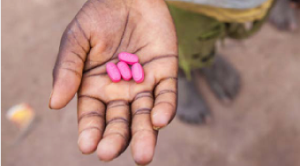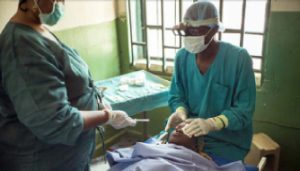Chlamydia trachomatis infection is stabilised but not eradicated by repeated antibiotic treatment
Rates of ocular chlamydia among children living in hyper-endemic areas of Africa can be stabilised with mass, annual or biannual azithromycin administrations, however according to the results of research published in PLoS Medicine, this approach fails to achieve the goal of complete eradication of the disease.
Conjunctivitis by Chlamydia trachomatis
The Chlamydia trachomatis is the most common cause of infectious neonatal conjunctivitis, accounting for between 2% and 40% of cases.
Trachoma constitutes the main cause of blindness in areas where the infection is hyper-endemic, concentrated in Africa and especially in northern Ethiopia.
The Chlamydia is the most sexually transmitted bacterial infection. the world. The estimated global incidence of the infection is approximately 131 million new cases per year.
the world. The estimated global incidence of the infection is approximately 131 million new cases per year.
Although the Chlamydia trachomatis typically affects sexually active adults, it can be transmitted to infants by the infected mother during childbirth.
Approximately 30-50% of children born to a mother with active Chlamydia will develop neonatal conjunctivitis.
Chlamydia trachomatis
Chlamydia trachomatis is a gram-negative, obligate intracellular parasite bacterium belonging to the Chlamydiaceae family.
This micro-organism is characterised by two cellular stages that alternate during the development cycle: the elementary body, which is 200-300 nm in size, unable to reproduce, but able to survive outside the host cell, and the reticular body, which reaches a size of 1000 nm, able to reproduce, but lacking the ability to infect. The reticular body multiplies within the infected cell, and then undergoes a reorganisation process that transforms it into an elementary body, which escapes from the infected cell following a process of exocytosis. This means that the mechanism of pathogenesis linked to C. trachomatis is indirect: the immune response triggered locally induces local inflammation resulting in the replacement of epithelial tissue by fibrotic tissue. Transmission, therefore, occurs through the elementary body, by inter-human contagion, either sexually or via the maternal-fetal route.
Conjunctivitis by Chlamydia trachomatis
Neonatal conjunctivitis caused by Chlamydia trachomatis is an acute infection of the conjunctiva characterised by erythema, swelling and oedema of the eyelids and palpebral conjunctiva and purulent ocular discharge. It usually occurs 5-14 days after birth.
Although it is generally a mild disease, complications such as scarring of the cornea or conjunctiva can occur if it is not treated promptly.
In addition, up to 20% of infants exposed to Chlamydia during delivery may develop pneumonia and in about 50% of them there is evidence of previous conjunctivitis.
Therapeutic approaches
For the treatment of infants with conjunctivitis by Chlamydia trachomatisthe World Health Organisation (WHO) guidelines for the  sexually transmitted diseases recommend using azithromycin in an oral formulation, 20mg/kg/day, one dose per day for 3 days.
sexually transmitted diseases recommend using azithromycin in an oral formulation, 20mg/kg/day, one dose per day for 3 days.
Azithromycin is preferred over erythromycin because of the potential risk of serious adverse events (such as pyloric stenosis) in infants treated with erythromycin.
Prophylaxis for the prevention of neonatal conjunctivitis
Due to the potential complications associated with neonatal ophthalmia, many countries have implemented routine prophylaxis or preventive treatment for neonatal conjunctivitis.
Agents currently used in the prevention of neonatal ophthalmia include1:
- 1% silver nitrate for topical use
- targesin (a compound of silver and protein)
- tetracycline at 1%
- topical macrolide antibiotics, including erythromycin 0.5% or azithromycin
- topical aminoglycosides, including gentamicin and tobramycin
- chloramphenicol
- fluoroquinolones, including ciprofloxacin
- iodopovidone at 1.25% or 2.5%
- fusidic acid
Neonatal screening
Several high-income countries have abandoned newborn eye prophylaxis and replaced it with routine prenatal screening and treatment of mothers with a sexually transmitted infection, resulting in a decrease in the incidence of neonatal Chlamydia and Gonorrhoea infections.
The WHO guidelines for sexually transmitted diseases recommend, however, topical eye prophylaxis for the prevention of neonatal gonococcal and Chlamydia conjunctivitis for all newborns.
WHO Guidelines
The World Health Organisation (WHO) recommends that individual or sporadic cases of trachomatous-follicular inflammation be treated topically. The WHO also recommends topical treatment for intense trachomatous inflammation, but such systemic treatment must be considered. Trachomatous scars alone do not require treatment until they progress and cause trachomatous trichiasis.
Systemic treatment
For systemic treatment, a single oral dose of azithromycin 20 mg/kg (maximum 1 g) is effective from 78 to 95%. As an additional benefit, the use of oral azithromycin has been associated with a significant reduction in overall infant mortality. Alternatives include erythromycin 500 mg 2 times/day for 14 days or doxycycline 100 mg 2 times/day for 10 days (not to be used in pregnant or lactating women or children under 8 years of age).
Topical treatment
For topical treatment, tetracycline ointment 1% can be used on both eyes 2 times/day for 6 weeks.
Surgical treatment
 The WHO recommends eyelid surgery for trachomatous trichiasis. If the corneal opacity has progressed to the central cornea, it is considered the stage of irreversible, untreatable blindness. In resource-rich nations a cornea transplant is required can restore sight. The procedure is complex, and the need for frequent and intensive care after treatment to prevent rejection and infection makes corneal transplantation impractical for many patients in most countries with limited resources.
The WHO recommends eyelid surgery for trachomatous trichiasis. If the corneal opacity has progressed to the central cornea, it is considered the stage of irreversible, untreatable blindness. In resource-rich nations a cornea transplant is required can restore sight. The procedure is complex, and the need for frequent and intensive care after treatment to prevent rejection and infection makes corneal transplantation impractical for many patients in most countries with limited resources.
Multiple rounds of antibiotic therapy
Concerning multiple rounds of antibiotic therapy, doubts arose as to their actual efficacy, which were later confirmed by the results of the study by the team from the University of California, San Francisco, led by Prof. Jeremy D. Keenan.
The Chlamydia Therapy Study
The 7-year study observed 48 communities with a total of 3,938 children, aged 0-9 years, and included 4 annual cycles of treatment with azithromycin followed by randomisation for continuation or discontinuation of treatment. In a selected sample of children, at 36 months from baseline, it appeared that in the communities that had continued to receive treatment, despite 7 years of annual treatment, the infection was not eradicated, but had a prevalence of 6.6%. This figure was, however, significantly lower than in the communities where azithromycin had been discontinued, which reached a prevalence of 14.7%. In neither branch of the study was the threshold <5% TF, established as the withdrawal level, reached.
Prof. Keenan then drew the conclusion that 'Communities in which annual or biannual mass azithromycin administrations were continued had the stabilisation of the infection and clinical disease, suggesting that antibiotics alone are not sufficient for total eradication of infection in hyper-endemic areas. However, continuing with mass distribution of azithromycin after three to five years is far better to maintain low levels of ocular chlamydiarather than discontinuing the treatment'.

To help little brothers Sililo, 6 years old, and Maimbolwa, only 3 years old (pictured) see https://www.sightsavers.it/appelli-speciali/2018/01/tu-fai-la-differenza-contro-il-tracoma/
Keenan JD, Tadesse Z, Gebresillasie S et al. Mass azithromycin distribution for hyperendemic trachoma following a cluster-randomised trial: A continuation study of randomly reassigned subclusters (TANA II). PLoS Med. 2018 Aug 14;15(8):e1002633. doi: 10.1371/journal.pmed.1002633. eCollection 2018 Aug.
